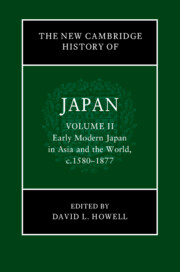Book contents
- The New Cambridge History of Japan
- The New Cambridge History of Japan
- The New Cambridge History of Japan
- Copyright page
- Contents
- Figures
- Maps
- Tables
- Contributors to Volume II
- Preface
- Frontispiece
- Introduction
- Part I The Character of the Early Modern State
- 1 The End of Civil War and the Formation of the Early Modern State in Japan
- 2 Politics and Political Thought in the Mature Early Modern State in Japan, 1650–1830
- 3 Regional Authority during the Tokugawa Period
- 4 Tokugawa Philosophy
- 5 Foreign Relations and Coastal Defense under the Mature Tokugawa Regime
- 6 The Meiji Restoration
- PART II Economy, Environment, and Technology
- Part III Social Practices and Cultures of Early Modern Japan
- Index
- References
4 - Tokugawa Philosophy
A Socio-Historical Introduction
from Part I - The Character of the Early Modern State
Published online by Cambridge University Press: 15 January 2024
- The New Cambridge History of Japan
- The New Cambridge History of Japan
- The New Cambridge History of Japan
- Copyright page
- Contents
- Figures
- Maps
- Tables
- Contributors to Volume II
- Preface
- Frontispiece
- Introduction
- Part I The Character of the Early Modern State
- 1 The End of Civil War and the Formation of the Early Modern State in Japan
- 2 Politics and Political Thought in the Mature Early Modern State in Japan, 1650–1830
- 3 Regional Authority during the Tokugawa Period
- 4 Tokugawa Philosophy
- 5 Foreign Relations and Coastal Defense under the Mature Tokugawa Regime
- 6 The Meiji Restoration
- PART II Economy, Environment, and Technology
- Part III Social Practices and Cultures of Early Modern Japan
- Index
- References
Summary
This chapter situates in the social context of Tokugawa Japan the emergence of a class of scholars who engaged in the production of texts and in practices that aimed at developing authoritative inquiries on the nature of reality and the laws that govern it (metaphysics); the motivations, norms, and aims of moral life (ethics); the function and rules of language (philology and linguistics); the principles of good government (politics); and the legitimation of cognitive claims (epistemology), among others. Operating within different institutional frameworks and through texts circulating in a variety of formats (manuscript and printed commentaries, treatises, glossaries, dictionaries, collected lecture notes, etc.), these scholars (generically known as jusha) developed a philosophical archive that should be regarded as a qualitatively and quantitatively unprecedented event in Japanese history outside Buddhist institutions.
Keywords
- Type
- Chapter
- Information
- The New Cambridge History of Japan , pp. 128 - 158Publisher: Cambridge University PressPrint publication year: 2023



